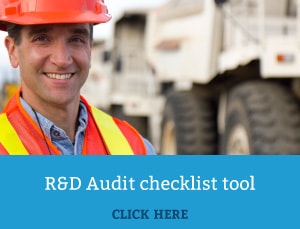ATO to review R&D Tax Incentive for construction activities
February 24th, 2017The arrangements of certain building and construction industry participants that are claiming the R&D Tax Incentive are being reviewed by the ATO and AusIndustry.The arrangements under review concern R&D claimants who are involved in either:

Acquiring buildings or extensions
Alterations or improvements
Constructing, extending, altering or improving buildings.
The review applies for instances where some or all of the expenditure:
- Is incurred on building and construction activities, which are expressly excluded from being taken into account in calculating an R&D tax offset.
- Does not otherwise relate to the eligible R&D activities.
Concerns
While operators of some affected companies may believe or have been advised that their activities constitute eligible R&D activities, the concern is that:
- Activities may not fit within the stringent requirements of the laws that govern the R&D Tax Incentive.
- Expenditure claimed may not relate to eligible R&D activities or may be specifically excluded from the calculation of the R&D Tax Incentive.
- Taxpayers may not be applying adequate levels of governance and review to the registered activities and the claims made for the R&D Tax Incentive.
Observed Activities
A number of cases have been observed where the acquirer and/or the builder of a building have registered construction activities with AusIndustry which are, or appear to be, ineligible for the R&D Tax Incentive.
Reasoning for ineligibility
- The activities are undertaken by the builder in the ordinary execution of the construction contract and are not undertaken for a significant purpose of generating new knowledge.
- Project management, environmental, commercial or economic risks are mistaken for technical risks.
- The activities are not experimental but rather involve solving issues by applying existing knowledge or methodologies and a suitably qualified and competent professional in the building and construction industry could have known or worked out the outcomes without conducting an experiment. For example, using and applying existing (even if they are quite new) building materials, designs, processes or modelling techniques to the local conditions or customer requirements.
Expenditure
It has also been observed that often some or all of the expenses included in the calculation of the R&D Tax Incentive claim are not correct. This is due to:
- The expenditure being significantly excluded from the R&D Tax Incentive, on the basis that it is incurred to acquire or construct
- A building or part of a building
- An extension, alteration or improvement to a building
- The expenditure included in the calculation of the R&D Tax Incentive is not for amounts that are incurred on eligible R&D activities; for example, production costs of products sold to the market in the ordinary course of business.
- Expenditure is being apportioned between R&D activities and ineligible ordinary business activities in an unreasonable manner. For example:
- Expenditure is included as part of overall overhead expenses which does not relate to R&D activities; for example, advertising and sales expenses.
- Overhead expenses are apportioned using a method that allocates an unreasonably large amount to R&D.
- The activities are conducted under contract for the acquirer or owner of the building and not for the builder itself, resulting in activities that are not conducted on the builder’s own behalf. Consequently, the expenditure incurred by the builder may not be at risk, as is required under the legislation.
Corporate Governance
It is expected that Companies distinguish eligible R&D activities from ineligible ordinary business activities at the time of registration and throughout the conduct of the activities. Proper, detailed and contemporaneous records must be kept to support the registration application and the claim for the R&D Tax Incentive.
A further concern is that some companies are not applying adequate levels of governance and review to the R&D activities that have been registered and to the claims that are subsequently made for the R&D Tax Incentive on their behalf. For example:
- Suitably qualified company officers or employees who understand the relevant activities failing to undertake reviews and approvals of the company’s R&D registration applications.
- Company management deferring responsibility for distinguishing ordinary business activities from R&D activities to external advisors, without checking whether the external advisors’ understanding of the eligible activities aligns with that of the company’s officers or employees.
- Accounting systems or records being kept which do not contemporaneously or adequately segregate R&D expenses from other expenses.
It has been observed that these practices can result in activities being registered as R&D activities and expenditures being claimed under the R&D Tax Incentive that should not be.
Actions taken by ATO
The ATO and AusIndustry are working together to alert taxpayers and their advisors to practices that may result in increased risk of registering ineligible activities and incorrectly claiming the R&D Tax Incentive.
We will be contacting companies directly to advise them of our concerns with their registered activities and/or their R&D Tax Incentive claims if:
- Advisors who may apply high-risk practices are involved in the preparation of the registration application and/or claim.
- The registration of R&D activities continues with the use of broad descriptions that fail to distinguish them from ordinary business activities.
- The level of expenditure claimed for the R&D Tax Incentive is high for the industry or stage of business.
Innovation and Science Australia will continue to issue findings to companies confirming whether activities qualify for the R&D Tax Incentive.
A Specific Issue Guidance product has been developed to assist companies engaged in the construction industry, and their accountants and advisors, to correctly identify and document eligible R&D activities in that industry. This product is available on www.business.gov.au
Actions to be taken by Claimers
You should consider whether the following concerns apply to you. The onus is on the individual to ensure that your registration and claim for the R&D Tax Incentive is correct. It is encouraged that:
- Registration is reviewed to ensure that only eligible R&D activities are registered.
- Claims for the R&D Tax Incentive are correct and that claims are not being made on expenditure related to ineligible activities.
- Check that the records demonstrate the R&D activities being undertaken and support the associated R&D Tax Incentive claim.
If the following concerns apply, it is encouraged to:
- Phone ATO: 1800 177 006
- Seek independent professional advice.
- Ask the ATO for their view through a private ruling or apply for a Finding from Innovation and Science Australia.
- Apply to AusIndustry to amend or withdraw your registration or make a voluntary disclosure to the ATO or amend your tax return.
Penalties may apply if you have incorrectly claimed the R&D Tax Incentive but will be significantly reduced if you make a voluntary disclosure. Generally, the reduction is greater if you make the disclosure before we notify you of an examination of your tax affairs.
For more information about eligible R&D activities, what can be claimed under the R&D Tax Incentive and recordkeeping, refer to Research and development tax incentive
If you have any further questions, please contact one our R&D tax specialists.
Categories
- ATO Guidance and Materials
- AusIndustry Guidance and Materials
- Case Law
- Federal Budget 2021
- Federal Budget 2022
- For Accountants
- General Information
- Government Policy and Treasury
- Industry Specific Issues
- Interpretative Decisions
- Legislation and Parliamentary Matters
- R&D Tax Credit
- R&D Tax Funding Strategies
- R&D Tax Loans
- Recent News
- Tax Determinations
Archives
- May 2024
- April 2024
- March 2024
- February 2024
- January 2024
- December 2023
- November 2023
- October 2023
- September 2023
- August 2023
- July 2023
- June 2023
- May 2023
- April 2023
- March 2023
- February 2023
- January 2023
- December 2022
- November 2022
- October 2022
- September 2022
- August 2022
- July 2022
- June 2022
- May 2022
- April 2022
- March 2022
- February 2022
- January 2022
- December 2021
- November 2021
- October 2021
- September 2021
- August 2021
- July 2021
- June 2021
- May 2021
- April 2021
- March 2021
- February 2021
- January 2021
- December 2020
- November 2020
- October 2020
- September 2020
- August 2020
- July 2020
- June 2020
- May 2020
- April 2020
- March 2020
- February 2020
- January 2020
- December 2019
- November 2019
- October 2019
- September 2019
- August 2019
- July 2019
- June 2019
- May 2019
- April 2019
- March 2019
- February 2019
- January 2019
- December 2018
- November 2018
- September 2018
- July 2018
- June 2018
- May 2018
- April 2018
- March 2018
- February 2018
- January 2018
- December 2017
- November 2017
- September 2017
- August 2017
- July 2017
- June 2017
- May 2017
- April 2017
- March 2017
- February 2017
- January 2017
- December 2016
- November 2016
- October 2016
- September 2016
- August 2016
- July 2016
- June 2016
- May 2016
- April 2016
- March 2016
- February 2016
- January 2016
- December 2015
- November 2015
- October 2015
- September 2015
- August 2015
- July 2015
- June 2015
- May 2015
- April 2015
- March 2015
- February 2015
- January 2015
- November 2014
- October 2014
- September 2014
- August 2014
- July 2014
- June 2014
- May 2014
- April 2014
- March 2014
- February 2014
- January 2014
- December 2013
- November 2013
- October 2013
- September 2013
- May 2013
- April 2013
- March 2013
- September 2012
- August 2012
- June 2012


 Free Call: 1300 009 390
Free Call: 1300 009 390





 News & Research
News & Research



